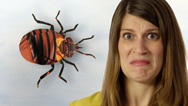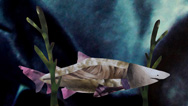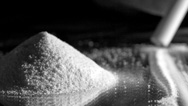The Mites That Live On Your Face
- By Anna Rothschild
- Posted 06.04.15
- NOVA
Right now, there are tiny mites eating, laying eggs, dying, and leaking feces on your face. Learn more in this episode of Gross Science.
Transcript
The Mites That Live On Your Face
Posted: June 4, 2015
What if I told you that right now, you have dozens of tiny mites eating, laying eggs, dying, and leaking feces—all over your face?
Turns out, you probably do.
I’m Anna Rothschild, and this is Gross Science.
Face mites, or Demodex mites, are wormy-looking creatures with eight tiny legs. They’re actually arachnids, related to spiders, scorpions, and ticks, and they’re really common. They’re found in pretty much every society on the planet, and most healthy adults have at least a few.
People usually acquire their first mites during childhood, but the mites don’t really start getting busy til you hit puberty.
That’s because face mites love oily skin. They live in the hair follicles on your forehead, cheeks and nose, or depending on the species, inside the sebaceous—or oil producing—glands surrounding those follicles.
They eat sebum, or skin oil, and also slurp out the insides of your dead skin cells. And that’s where things get really gross. You see, face mites don’t have anuses. They store all of their waste in their abdomens until the day they die. At which point they decompose and leak feces all over your face.
In fact, some scientists think that the bacteria in their poop could be related to certain skin condition, like rosacea or blepharitis.
Each mite only lives for about two weeks, but that’s more than enough time for them to crawl out onto your skin at night to mate around the edges of your hair follicles. The female then burrows back and lays one gigantic egg. Two and a half days later you’ve got a brand new baby mite, ready to once again begin the circle of life… on your face.
Ew.
Credits
PRODUCTION CREDITS:
- Host, Animator, Editor
- Anna Rothschild
- DP, Sound, Writer
- Kristen Clark
- Many thanks to Dr. Dan Fergus and Dr. Anne A. Madden.
- Music: “Moondots and Polkabeams”
- ©Podington Bear
IMAGES AND VIDEO
- Image of Face Mite and Video of Mite Laying Egg
- ©Your Wild Life, North Carolina State University
- Acne Rosacea, man
- Wellcome Library, London/A. Henning
- Blepharitis
- Wikimedia Common/clubtable
SFX
- Cockroaches
- Freesound/StateAardvark
(used with permission from author) - Squeak Pack/squeak_10
- Freesound/Corsica_S
- Bubbling Popping
- Freesound/ch0cchi
- Produced by WGBH for PBS Digital Studios
IMAGE
- (main image: Face mites kissing)
- ©WGBH Educational Foundation 2015
Sources
Want more info?
Your Wild Life—Meet Your Mites:
http://bit.ly/1KBhGaT
Mites and Rosacea:
http://jmm.sgmjournals.org/content/61/Pt_11/1504.full.pdf+html?sid=29c72a69-5b27-422d-a43d-557697566279
Related Links
-

Gross Science
Bizarre stories from the slimy, smelly, creepy world of science.
-

Herpes and the Brain
Herpes is probably hiding in your nerve cells right now.
-

When Shark Fetuses Attack
Sand tiger shark fetuses eat their siblings in the womb.
-

Can Cocaine Make Your Ears Rot?
Cocaine is being mixed with a dangerous drug called levamisole.

